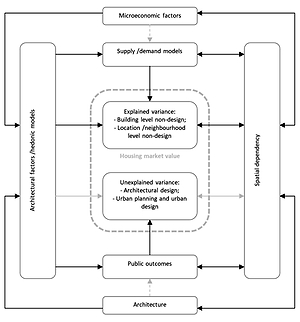Current issue
Online first
Archive
About the Journal
Aims and scope
Editorial Board
International Editorial Board
List of Reviewers
Abstracting and indexing
Ethical standards and procedures
REMV in Social Media
Contact
Instructions for Authors
Instructions for Authors
Manuscript formatting template
Title page
Highlights
Payments
‘Ghostwriting’ and ‘Guestauthorship’
Guidelines for Referees
Architectural factors influencing a housing market value: A theoretical framework
1
School of Economics and Business, Kaunas University of Technology, Lithuania
2
School of Economics and Business, Kaunas University of Technology and Department of Economics, Lithuania Business University of Applied Sciences, Lithuania
Submission date: 2022-04-12
Final revision date: 2022-06-03
Acceptance date: 2022-06-16
Publication date: 2023-03-10
REMV; 2023;31(1):25-35
HIGHLIGHTS
- the misalignment of estimated market value between different approaches indicates the existing unexplained variance
- architecture and real estate economics should be considered as a complex system that cannot be analysed in parts
- architectural factors can be classified as a matrix of built environment properties
KEYWORDS
TOPICS
D46 - Value TheoryR32 - Other Spatial Production and Pricing AnalysisR31 - Housing Supply and Markets
ABSTRACT
A housing price, not considering its change over time, is widely determined by hedonic properties. This is common in literature; however, there is a significant part of a price, the so-called unexplained variance, that is not captured by hedonic models. The scientific problem of this research is how to classify and visualize architectural factors that might have an influence on the market value of a dwelling. The object of the research are architectural factors in a housing market value analysis and the aim of research is to describe the theoretical framework that defines the structure and scope of architectural variables influencing a housing market value. Not all architectural factors described in the literature review are equal in terms of scale, measurability, public or private context, aesthetic or functional priority. A systematic approach would be to classify architectural factors as a matrix of built environment properties. Two orthogonal dimensions can be identified: architectural factors spanning from non-design (functional, utilitarian) to design (abstract, unexplained) and factors spanning from architectural design (private) to urban design (public). A multidimensional and complex system of architectural variables influencing a housing market value exists. Understanding this system is crucial for a housing development to succeed.
We process personal data collected when visiting the website. The function of obtaining information about users and their behavior is carried out by voluntarily entered information in forms and saving cookies in end devices. Data, including cookies, are used to provide services, improve the user experience and to analyze the traffic in accordance with the Privacy policy. Data are also collected and processed by Google Analytics tool (more).
You can change cookies settings in your browser. Restricted use of cookies in the browser configuration may affect some functionalities of the website.
You can change cookies settings in your browser. Restricted use of cookies in the browser configuration may affect some functionalities of the website.



